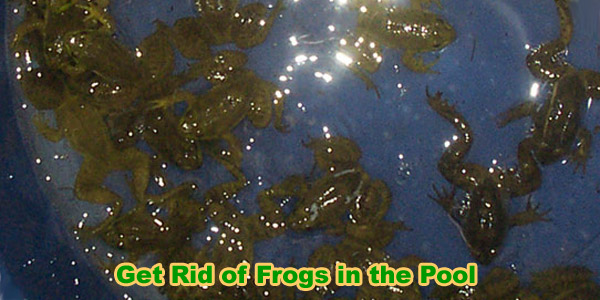- info@wildlife-removal.com
Call us for help in your town
Wildlife Removal Education
How to Get Rid of Frogs in Your Pool
Need frog removal in your hometown? We service over 500 USA locations! Click here to hire us in your town and check prices - updated for year 2020.
In short, you can simply use the pool skimmer to scoop them out, and then let them go in the yard. If you have a screened-in pool area, but are still getting frogs, that means you have openings in the screen or under the doors, and you need to
seal those areas shut.
Click here for my nationwide list of 100's of professional reptile trappers serving all 50 states.
In the wild, frogs are generally considered unobtrusive. They are small animals and provide a desirable food source for many other creatures in nature. Because of their permeable skin, frogs must remain moist at all times. It is this need for hydration that sometimes causes them to become nuisance animals. Any homeowner with a private or decorative pond can tell you that they have probably had a frog in it at least once. Because these manicured water bodies lack the natural predators of the wild, frogs can move in and quickly over populate the available space. The frogs aren’t necessarily unpleasant in and of themselves, but their loud chorus at dusk can be an annoyance. If your pond happens to coincide with a garden, frogs have been known to dig into root sections and damage plants. Frogs don’t eat garden plants, this is something to keep in mind, but they do like the cool-moisture rich environment provided by a well maintained flower bed. Because they are handicapped on land, frogs frequently fall victim to lawnmowers and other maintenance tools. This can make for a very unpleasant aftermath and cleanup.

The easiest way to get rid of frogs is to get rid of your pond or fountain. If you don’t want to do that, you need to consider the reasons why the frogs are there in the first place. Lack of predators is a huge factor of why frogs overpopulate. Some house cats will eat frogs, but it’s not advised that you rely on a single cat to control your frog problem. An easy enough fix is to add some fish to your pond. Most fish love frog eggs and tadpoles, and a small pond will not provide enough space for the frog young to escape predation. In larger ponds this tactic will be more difficult, but by stocking large, hearty fish, you ensure that a good number of frog eggs will be consumed on a yearly basis. This method of frog control will not eliminate all of your frogs, but it will certainly reduce the frog numbers to a manageable amount. For larger ponds, consider getting fish that will eat adult frogs as well as tadpoles.
Another issue to consider when attempting to get rid of frogs is their food source. These amphibians are carnivorous, eating small insects and invertebrates. A slow moving pond will promote reproduction among many insect species. Consider aerating your water to prevent stagnation. Add a waterfall or a fountain to keep the water circulating. If the water is moving, insects will not be successful when they attempt to lay eggs. Without an abundance of insects, frogs will be less likely to move into your pond from another area.
Another tip for frog control is to regulate the water temperature in your pond. This is easy with a small, decorative pond and larger bodies of water may not be able to use this tactic. Frogs do not like hot water. If you can keep the water in your pond warm enough, they will not intrude. Keep in mind that warm water brings with it other issues such as algae and insect growth. Aquatic plants may not be able to survive in overly heated water.
Some studies have shown caffeine and citric acid as effective frog deterrents. Caffeine has been used in Hawaii for frog control. Due to their permeable skin, high doses of caffeine have proved fatal to the amphibians terrorizing the island.
You can also install a frog net around your water, but these are usually unsightly.
If all else fails, you can hire a professional to exterminate the frogs. These people are trained in frog removal and will know what type of traps work best. There are many do-it-yourself trapping methods out there, but most require a lot of time and effort on the homeowner’s part. Instead of taking your chances with a bucket and flashlight, hoping the frogs will jump in after insects attracted to the light, consider seeking help from an expert.


















